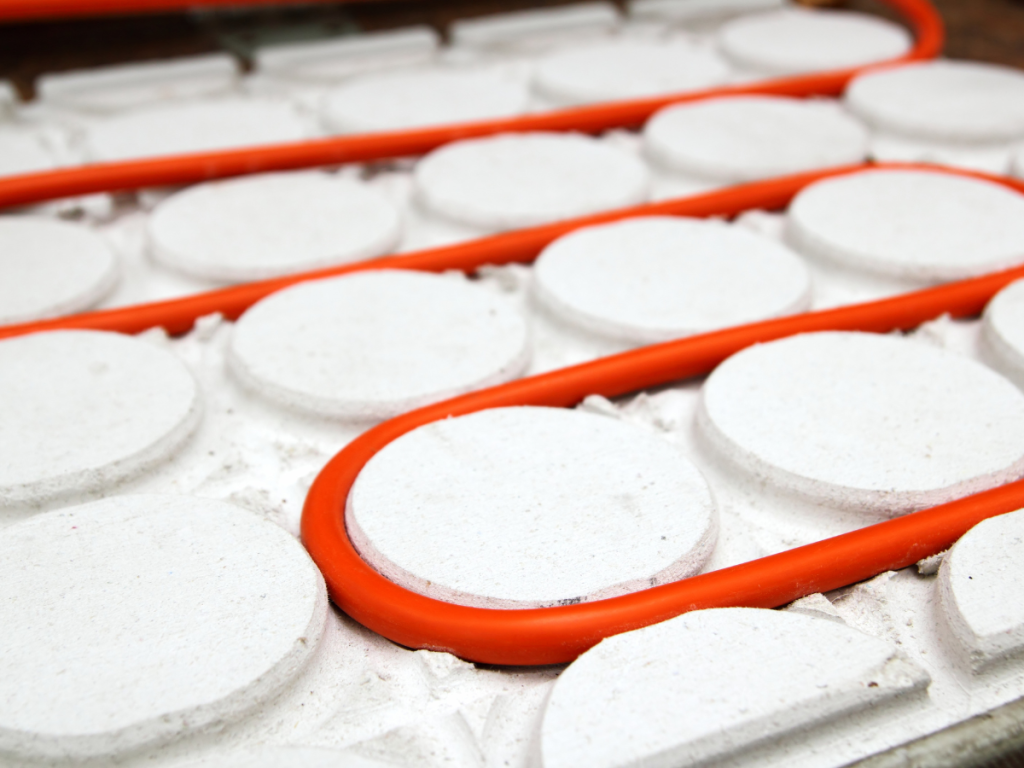Radiant floor heating systems are an appealing choice among homeowners thanks to their efficiency, comfort, and luxurious feel. But how much does it really cost?
In this guide, we’ll outline all of the factors affecting the cost of installing and operating radiant floor heating systems.
What is radiant heating?
Radiant heating is a heating system that uses radiating heat from elements installed under the floor to warm up a room. This method of heating provides several benefits, including energy efficiency, better distribution of heat, and increased comfort in the home.
One major advantage of radiant heating is that it tends not to take up precious space. Unlike traditional heating systems that require bulky radiators or vents, radiant heating is concealed under the floor and does not take up any additional space in a room.
In terms of the environment, radiant heating can also be more sustainable. Since it operates at lower temperatures than forced-air heating systems, there is less energy wasted, reducing carbon emissions. This gives incentive for homeowners looking to decrease their carbon footprint.
During the winter months, radiant heating can provide a cozy and comfortable environment. The warmth radiating from the floor eliminates cold spots typically experienced with traditional heating systems, making it a popular choice for those living in a colder climate.
For new home builds or a renovation project, radiant heating is becoming increasingly popular in the market. It adds value to a home, as potential buyers see it as a luxurious and modern addition. Plus, with the added energy efficiency benefits, it can also be a cost-saving feature for homeowners.
Are there any drawbacks to radiant heating?
While radiant heating has many benefits, there are some potential drawbacks to consider before installing a system in your home.
One of the main concerns with radiant heating is the upfront cost. Compared to traditional forced-air systems, radiant heating can be significantly more expensive to install. However, over time, the energy efficiency and cost-saving benefits may outweigh this initial investment.
Another drawback is that it can take longer for a room to reach the desired temperature with radiant heating. The heat radiates slowly from the floor, so it may not be ideal for those who want quick bursts of heat. However, once the room is warm, it tends to stay that way for longer periods of time.
Additionally, radiant heating can be more challenging and expensive to repair if any issues arise. The system is hidden under the floor, so accessing and fixing any problems can be more complicated and costly compared to traditional heating systems.
It’s also important to note that radiant heating may not work as well in homes with thick carpets or multiple layers of flooring. The dense materials can act as insulation, making it harder for the heat to transfer through the floors effectively.
Ultimately, the decision to install radiant heating in your home will depend on your personal preferences and budget. It’s important to consider all factors before making a decision.
Types of radiant floor heating systems
Homeowners today can choose between three primary radiant floor heating systems. Each has unique features and considerations when choosing one. Understanding them all will allow you to find the type best suited to your needs. Let’s take a closer look.
Hydronic radiant floor heating
Hydronic radiant floor heating is the most cost-effective and widely utilized type of floor heating system available today.
It uses a system of tubes to transport hot water from its source beneath the floor surface to where you need it. This type is great for heating larger areas and is usually considered in the mid-range in terms of cost (though with great value).
Electric radiant floor heating
Electric radiant floor heating tends to be cheaper to install.
This system uses electric cables or mats of electrically conductive plastic mounted directly onto the subfloor.
While initial installation costs may be more budget-friendly, ongoing costs could exceed expectations, especially in regions with costly electricity.
Air-heated radiant floor heating
Air-heated radiant floor heating systems use air to distribute heat but are typically not utilized in residential projects due to their inefficiency. Starting costs for air-heated radiant floor heating are typically higher.
Actual costs will depend on multiple factors like area size, system type, and labor costs in your region of the United States.
Factors influencing the cost of radiant floor heating installation
Several factors can impact the total cost of installing a radiant floor heating system in your home. Being aware of them can help you get a more accurate estimate.
The size of your space
Heating larger areas increases costs because more materials and a longer installation process will be required for each square foot. For instance, when comparing heating an entire house versus just one bathroom, the difference can be quite striking!
Flooring type
Your choice of flooring can also affect costs. Certain floor types are better suited for radiant heat installation than others, and ease of installation may vary accordingly.
Tile is an excellent heat conductor and is easy to install, while hardwood could require special precautions against damage from heat exposure, increasing installation costs significantly.
Insulation considerations
Insulation plays a pivotal role in ensuring the efficiency of radiant floor heating systems, keeping heat inside where it belongs so less energy is required.
If your home doesn’t have sufficient insulation, looking into adding it could be worthwhile. One environmental factor to consider in whether to have it added to your home is the climate you live in. The colder the climate you reside in, the more it’s recommended.
DIY vs. professional installation costs
When considering radiant floor heating installation, weighing the pros and cons of DIY versus hiring a professional is important.
DIY radiant floor heating installation
DIY installations can be a cost-cutting option. If you enjoy being hands-on and like taking on new challenges, installing the system yourself may save on labor costs.
Make no mistake, however: DIY projects will require significant time commitment and in-depth knowledge of installation procedures in order to be completed successfully and in a way that prioritizes safety.
Mistakes could cause ineffective heating or even damage to your home, ultimately costing more in the long run, so this option should be considered carefully and is generally not recommended.
Professional radiant floor heating installation
Hiring a professional installer can ensure a stress-free and efficient installation experience, as professionals come equipped with years of experience, expertise, and problem solving skills.
Professional installation offers many advantages, allowing you to mitigate the risk of potential issues and ensure the system is installed properly and with guaranteed satisfaction.
Tips for reducing radiant floor heating costs
Below are some ways you can reduce the costs associated with radiant floor heating:
- Choose energy-efficient systems: Energy-efficient systems will help lower long-term operational costs. While there may be a higher initial price, in the long run, you’ll save money through reduced energy usage
- Insulation is key: Insulation can play an integral part in increasing the efficiency of radiant floor heating systems by preventing heat loss. Make sure each location where the heating systems are installed is sufficiently insulated
- Opt for affordable and efficient flooring materials: Some flooring types conduct heat better than others. Materials like porcelain and ceramic tile have high thermal conductivity rates and retain heat well, making your system more effective
- Regular maintenance: Like any system, regular maintenance will extend the lifespan and increase the efficiency of a radiant floor heating system. This includes inspecting and cleaning it on an ongoing basis to ensure it operates at an optimal level
- Smart thermostat: Installing a smart thermostat can improve the energy efficiency of your radiant floor heating system. This unit allows you to program temperature settings at different times throughout the day and save energy when it’s not needed
Looking for radiant floor installations? Contact Plumb-Tech!
At its core, radiant floor heating brings comfort and efficiency into any home; however, understanding its cost factors is key to making an informed decision.
Are you ready to experience radiant floor heating? Connect with Plumb-Tech’s local experts for a quote tailored specifically for your space! Contact us today for that or any other plumbing service!





